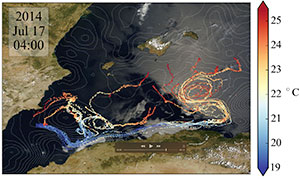Multi-platform experiments, numerical simulations ANd dATa sciEnce techniques for generation of new altimEtric products: focus on mesoscale and sub-mesoscale variability in the Western Mediterranean Sea (MANATEE)
Author:
Ananda Pascual - (Institut Mediterrani d’Estudis Avançats, IMEDEA(CSIC-UIB))
Co-Principal Investigator(s):
Ronan Fablet (UMR LabSTICC)
Evan Mason (Institut Mediterrani d’Estudis Avançats, IMEDEA(CSIC-UIB))
Co-Investigator(s):
Pierre Ailliot (Univesité Bretagne Occidentale, Brest)
Giuseppe Aulicino (Università Politecnica delle Marche, Ancona)
Bertrand Chapron (Ifremer)
Yuri Cotroneo (Università degli Studi di Napoli “Parthenope”)
Yannice Faugère ( CLS)
Cristina Gonzalez-Haro (Institut Mines-Télécom/Télécom Bretagne)
Laura Gómez-Navarro ( IMEDEA(CSIC-UIB))
Cédric Herzet (Institut Mines-Télécom/Télécom Bretagne)
Ismael Hernández-Carrasco (SOCIB)
Manuel Lopez-Radcenco (Institut Mines-Télécom/Télécom Bretagne)
Baptiste Mourre (SOCIB)
Simón Ruiz ( IMEDEA(CSIC-UIB))
Antonio Sánchez-Román ( IMEDEA(CSIC-UIB))
Pierre Tandeo (Institut Mines-Télécom/Télécom Bretagne)
Joaquin Tintoré (IMEDEA(CSIC-UIB) and SOCIB)
Charles Troupin (SOCIB)
Jacques Verron (LGGE)
Abstract:

Satellite altimetry has revolutionized our understanding of surface circulation in the global ocean as a result of the continuous sea surface topography measurements provided by several altimeter missions (TOPEX/Poseidon, ERS-1, ERS-2, Geosat Follow-On, Jason-1, Envisat and OSTM/Jason-2). In two decades of this research, major breakthroughs have been achieved, especially mesocale ocean dynamics. A wide range of published studies have used altimetry observations for both global and regional applications.
The Mediterranean Sea offers a range of interesting processes, open challenges, and questions. It is a natural reduced-scale laboratory basin for the examination of processes of global importance. Intense mesoscale and submesoscale variability occurs at sub-basin and basin scales, resulting in an amalgam of intricate processes that require high-resolution and comprehensive observations to be fully understood. Altimetric data offer a realistic description of sea surface variability in the Mediterranean. Most studies above were based on the combination of two altimeter missions, which do not fully resolve mesoscale structures of 10-100 km, the typical scale for the Mediterranean Sea. It is then necessary to complement altimetry data with alternative remote and in situ sensors to fully characterize the three-dimensional circulation covering the full spectrum of spatio-temporal scales. Moreover, multi-source data also help in distinguishing noise from small dynamical structures as a result of crosscalibrations and validations between the different sensors. This assemblage of multi-source alternative data paves the way to a complete exploitation of the available observation systems, which is likely to lead to improved capabilities for mesoscale studies.
The general objective of this project is to improve the characterization of oceanic mesoscale and sub-mesoscale features (e.g fronts, meanders, eddies and filaments) through the combined use of, in-situ and satellite data in synergy with numerical models and innovative computational techniques. The ultimate goal is to enhance our understanding of the impact of finescale processes. Gathering a unique multidisciplinary expertise in physical oceanography, satellite remote sensing, in situ monitoring and computational science, we will asses our actual capability to map the SSH variability for a range of scales (15-100 km) traditionally not resolved by conventional altimeters. It is obviously anticipated that the 2D SSH imaging potential of the SWOT satellite will enable much direct methods. Yet, taking advantage of the actual golden altimeter-observation era, with up to six altimeters in orbit, we propose in the frame of this project, to advance and test new methods to map the sea surface height field, using this unprecedented altimeter constellation data, jointly with numerical, statistical and analytical models. The area of study will be the western Mediterranean, one of the two sub-basins of the Mediterranean Sea, where the circulation is complex due to the presence of multiple interacting scales, including basin scale, sub-basin scale and mesoscale dynamics.
